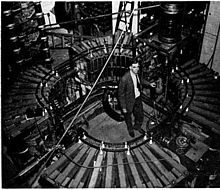
Back مسرع دوراني تزامني Arabic Sincrotrón AST Сінхратрон Byelorussian Синхротрон Bulgarian Sincrotró Catalan Synchrotron Czech Synchrotron German Σύγχροτρο Greek Sincrotrón Spanish Sünkrotron Estonian

A synchrotron is a particular type of cyclic particle accelerator, descended from the cyclotron, in which the accelerating particle beam travels around a fixed closed-loop path. The magnetic field which bends the particle beam into its closed path increases with time during the accelerating process, being synchronized to the increasing kinetic energy of the particles.[1] The synchrotron is one of the first accelerator concepts to enable the construction of large-scale facilities, since bending, beam focusing and acceleration can be separated into different components. The most powerful modern particle accelerators use versions of the synchrotron design. The largest synchrotron-type accelerator, also the largest particle accelerator in the world, is the 27-kilometre-circumference (17 mi) Large Hadron Collider (LHC) near Geneva, Switzerland, built in 2008 by the European Organization for Nuclear Research (CERN).[2] It can accelerate beams of protons to an energy of 7 tera electronvolts (TeV or 1012 eV).
The synchrotron principle was invented by Vladimir Veksler in 1944.[3] Edwin McMillan constructed the first electron synchrotron in 1945, arriving at the idea independently, having missed Veksler's publication (which was only available in a Soviet journal, although in English).[4][5][6] The first proton synchrotron was designed by Sir Marcus Oliphant[5][7] and built in 1952.[5]
- ^ Chao, A. W.; Mess, K. H.; Tigner, M.; et al., eds. (2013). Handbook of Accelerator Physics and Engineering (2nd ed.). World Scientific. doi:10.1142/8543. ISBN 978-981-4417-17-4. S2CID 108427390.
- ^ "The Large Hadron Collider". CERN. 2023-12-15. Retrieved 2024-01-15.
- ^ Veksler, V. I. (1944). "A new method of accelerating relativistic particles" (PDF). Comptes Rendus de l'Académie des Sciences de l'URSS. 43 (8): 346–348.
- ^ J. David Jackson and W.K.H. Panofsky (1996). "EDWIN MATTISON MCMILLAN: A Biographical Memoir" (PDF). National Academy of Sciences.
- ^ a b c Wilson. "Fifty Years of Synchrotrons" (PDF). CERN. Retrieved 2012-01-15.
- ^ Zinovyeva, Larisa. "On the question about the autophasing discovery authorship". Retrieved 2015-06-29.
- ^ Rotblat, Joseph (2000). "Obituary: Mark Oliphant (1901–2000)". Nature. 407 (6803): 468. doi:10.1038/35035202. PMID 11028988.
© MMXXIII Rich X Search. We shall prevail. All rights reserved. Rich X Search